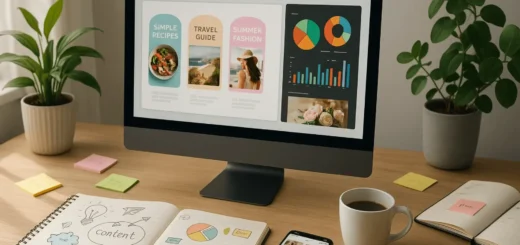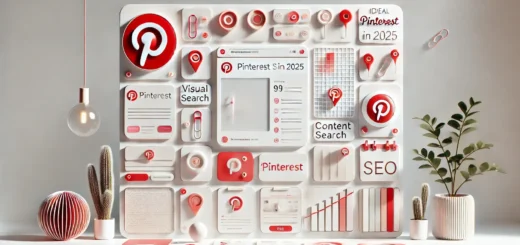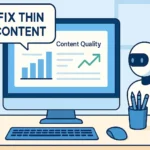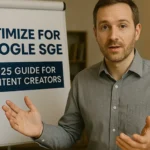Pinterest Content Planner & Calendar 2025: Free Template, Schedule & Pinterest Marketing System

Introduction: What Is a Pinterest Content Planner (and Why It Matters in 2025)
This guide is your starting point for building a consistent and scalable content system on Pinterest in 2025. It connects with deeper resources on Pinterest SEO, design, automation, and long-term growth.
Visual discovery platforms aren’t just aesthetic showcases—they’re powerful growth channels that drive over 5 billion searches monthly and generate more referral traffic than Twitter, LinkedIn, and Reddit combined. For bloggers, affiliate marketers, and e-commerce businesses, a strategic Pinterest content planner can transform your reach and revenue in 2025.
Unlike other platforms where content fades within 24 hours, visual content typically performs for an average of 3.5 months, and evergreen posts can deliver results for years to come. This longevity makes visual discovery channels ideal for sustainable, long-term traffic growth.
This comprehensive guide delivers a strategic content planning system — a month-by-month breakdown packed with seasonal strategies, trending topics, and actionable schedules aligned with user behavior and search intent. Get started with a reliable system to streamline your visual outreach and audience engagement planning.
How to Schedule and Structure Your Visual Content for Maximum Reach
The Science Behind Strategic Visual Content Planning
Visual discovery platforms operate on a seasonal discovery model where users plan 45-90 days ahead of time. When someone searches for “Christmas decorations” in October or “summer recipes” in April, they’re preparing for future needs. This forward-thinking approach unlocks significant opportunities for professionals who plan and publish visual content using a structured content scheduling system tailored for visual discovery platforms.
Successful content professionals organize their planning systems to stay ahead of seasonal shifts, preparing materials months in advance. This strategic approach ensures you produce content when competition is low and maximize visibility during peak demand.
Key Platform Statistics for 2025:
- 478 million monthly active users globally
- 85% of users make purchase decisions based on visual content
- Visual content receives 10x more engagement than Facebook posts.
- 98% of users try new things they discover on visual platforms
The Monetization Advantage
Strategic content planning directly impacts revenue through systematic media plan development.
If you’re looking to turn seasonal content into real income, explore our Pinterest affiliate marketing strategies guide to learn how to align posts with high-converting opportunities:
- Affiliate Marketing Opportunities: Seasonal content allows you to promote relevant affiliate products when demand peaks, creating a substantial increase in traffic and conversions
- Blog Traffic Growth: Properly timed content can drive consistent traffic for months, helping you grow your audience sustainably
- Product Launch Alignment: E-commerce businesses can maximize visibility when users actively seek solutions
Building Your Strategic Framework
Creating effective visual content plans requires understanding your niche and audience behavior patterns. A comprehensive media planner approach involves:
- Seasonal Analysis: Research when your target audience searches for specific topics
- Content Themes: Develop monthly themes that align with user intent
- Performance Tracking: Monitor key metric indicators to refine your content plan
- Content Optimization: Continuously adjust your approach based on performance data
This systematic creation process ensures you stay consistent while maintaining high-quality, engaging content that resonates with your audience.
↑ Back to Table of ContentsMonthly Pinterest Marketing Roadmap (With Tailwind & Seasonal Strategies)
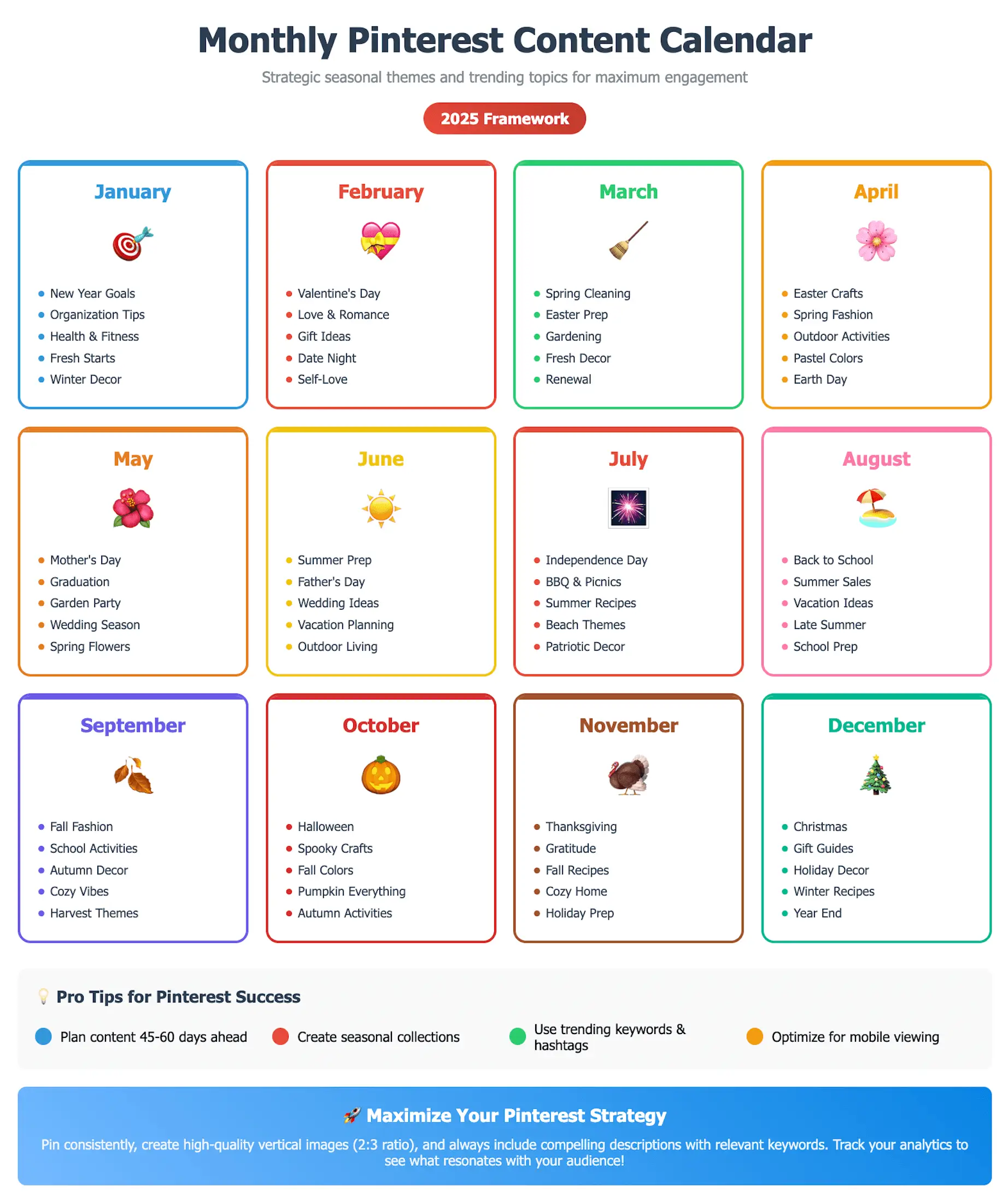
Q1: Building Momentum (January-March)
Successful Q1 campaigns require strategic content planning to create a content calendar that aligns with post-holiday behavior and spring preparation patterns.
January 2025: New Year, New Goals
- Primary Themes: Resolutions, organization, health, productivity, budgeting
- Peak Engagement: January 2-15
- Content Focus: Help users get organized and stay consistent with their resolutions.
- Content Ideas: Organization challenges, meal prep guides, budget planners, productivity resources
- Publishing Schedule: Create and schedule 5-7 visual posts daily to keep your content fresh
- Keywords: New year organization, healthy recipes 2025, budget planning, productivity tips
Content Creation Tips:
Save time by batch-creating January content in November and December. Pre-plan posts that align with resolution themes and address organizational challenges on your primary platforms.
February 2025: Love and Self-Care
- Primary Themes: Valentine’s Day, self-care, relationships, winter comfort
- Peak Engagement: February 1-14, 15-28 (self-care recovery phase)
- Strategic Focus: Create content that serves both romantic and self-love audiences
- Content Ideas: DIY Valentine’s gifts, romantic recipes, self-care routines, winter skincare
- Publishing Tip: Increase frequency during Valentine’s week to 6–8 posts daily.
March 2025: Spring Awakening
- Primary Themes: Spring cleaning, Easter preparation, gardening, fresh starts
- Content Development: Help you create content that addresses the psychological need for renewal
- Content Ideas: Spring cleaning checklists, home refresh ideas, container gardening guides
- Keywords: Spring cleaning tips, Easter recipes, container gardening, spring decor
Q2: Outdoor Adventures (April-June)
The second quarter requires a strategic shift in your media plan to capitalize on outdoor activity searches and celebration planning.
April 2025: Outdoor Living Begins
- Themes: Easter, spring activities, outdoor living, travel planning
- Content Focus: Create content around Easter activities, spring break packing, backyard entertaining, hiking essentials
- Strategic Timing: Publish Easter content early in March for maximum visibility
May 2025: Celebrations and Growth
- Themes: Mother’s Day, graduations, wedding season, garden peak
- Content Plan: Develop comprehensive gift guides and celebration planning content to support our customers.
- Content Ideas: Mother’s Day gifts, graduation parties, small space gardens, wedding shower games
- Keywords: Mother’s Day gifts, graduation party ideas, small space gardening
June 2025: Summer Preparation Peak
- Themes: Father’s Day, summer activities, weddings, outdoor living
- Content Focus: Create comprehensive summer preparation guides and celebration content
- Content Timing: Balance short-term events, like Father’s Day, with evergreen topics, such as summer activities.
Q3: Peak Summer to Fall Transition (July-September)
Third quarter success requires balancing immediate summer content with strategic fall preparation. Your objective should be maintaining summer engagement while planting seeds for autumn searches.
July 2025: Summer Peak Performance
- Themes: Fourth of July, vacation content, outdoor cooking
- Content Focus: Create content that serves both celebration and practical summer living needs.
- Content Ideas: Patriotic desserts, vacation packing guides, grilling recipe collections, beach day essentials
- Performance Goal: Aim for your highest engagement month with increased posting frequency
August 2025: Back-to-School Transition
- Themes: School preparation, late summer activities, early fall hints
- Strategic Focus: Help you grow your audience by serving parents and students preparing for the academic year
- Content Focus: Organization systems, school lunch planning, dorm decoration, teacher appreciation gifts
- Peak Engagement: August 1-25 (back-to-school shopping surge)
- Planning Tip: Begin incorporating early fall elements to stay ahead of seasonal transitions
September 2025: Autumn Awakening
- Themes: Fall decoration, apple harvest season, cozy content introduction, Halloween preparation
- Content Development: Create content that bridges the summer-to-fall transition effectively
- Strategic Elements: Fall porch decorating, apple recipe collections, cozy fashion inspiration, and early Halloween planning
- Strategic Timing Alert: October-ready Halloween content should be produced in advance for maximum seasonal reach.
Q4: Holiday Season Maximization (October-December)
The final quarter represents a peak opportunity for content publishers. Your media plan should prioritize maximizing holiday search demand and seasonal shopping activity.
October 2025: Halloween and Harvest Celebration
- Engagement Pattern: Consistent interest throughout the entire month
- Content Focus: Create content that serves both the Halloween celebration and cozy fall living
- Content Focus: DIY Halloween decorations, pumpkin recipe collections, party planning guides, cozy fall home decorations
- Publishing Approach: Maintain a high frequency to capture sustained seasonal interest.
November 2025: Gratitude and Holiday Preparation
- Peak Performance Days: November 1-28 (Thanksgiving preparation), 29-30 (Christmas preparation begins)
- Strategic Approach: Optimize content for both Thanksgiving immediate needs and Christmas planning
- Content Ideas: Thanksgiving menu planning ideas, gratitude journaling routines, Black Friday shopping tips, and early Christmas gift guide inspiration.
- Critical Timing: Publish Christmas content immediately after Thanksgiving for optimal visibility
December 2025: Holiday Peak Season
- Maximum Publishing: 10-12 posts daily through Christmas week
- Content Focus: Christmas cookie collections, last-minute gift solutions, holiday entertaining guides, New Year’s preparation
- Strategic Balance: Serve both immediate holiday needs and New Year’s planning searches
Media Planner Framework by Niche: Bloggers, Ecommerce & Affiliates
For Bloggers and Content Creators
Successful bloggers use Notion systems and structured planning methods to organize their content output, boosting visibility and seasonal engagement. The key is developing a strategic process that supports consistent content creation.
Content Distribution for Maximum Impact:
- 40% Original blog post promotion
- 30% Curated industry content
- 20% Inspirational quotes and quick tips
- 10% Behind-the-scenes and personal brand content
Strategic Best Practices:
- Create content in multiple visual formats for each blog post to maximize reach
- Optimize descriptions with seasonal keywords that align with current search behavior.
- Stay consistent with branding elements across all visual content
- Save time by batch-creating content during low-traffic periods
For E-commerce Businesses
E-commerce success requires a strategic content approach to deliver exactly what your audience is searching for during peak buying seasons.
Revenue-Focused Content Distribution:
- 50% Product showcase content in lifestyle contexts
- 25% Lifestyle content featuring products naturally
- 15% User-generated content and social proof
- 10% Educational content that builds brand authority
High-Converting Content Methods:
- Optimize product descriptions for seasonal search terms
- Create content that shows products in real-life usage scenarios
- Continuously monitor your visual commerce performance metrics to gain insights and optimize your strategy.
- Keep your content fresh with new product photography and seasonal styling.
For Affiliate Marketers
Successful affiliate campaigns rely on a well-timed content roadmap that strikes a balance between product promotion and audience expectations.
Strategic Content Framework:
- 35% Product review and comparison content
- 30% Tutorial content featuring affiliate products naturally
- 25% Seasonal gift guides and product recommendations
- 10% Educational content that builds niche authority
Monetization Best Practices:
- Create content that genuinely helps your audience solve problems
- Optimize promotional content timing with seasonal demand peaks
- Stay proactive by promoting relevant products before peak seasonal demand.
- Track affiliate performance metrics across your visual discovery campaigns.
Canva, Boards & Weekly Workflow: Design Pins That Perform
Keyword Research and Strategic Implementation
Visual discovery platforms function like search engines, making keyword research essential for successful content planning. Learn how to build a keyword system that drives long-term traffic growth in our complete Pinterest keyword strategy guide.
Essential Research Tools for Content Planning:
- Platform Insights Tool (free, built-in analytics)
- Search Suggestion Autocomplete Analysis
- Google Keyword Planner for volume insights
- Native analytics for performance tracking
Strategic Optimization Framework:
- Content Titles: Include primary keywords in the first 50 characters naturally
- Descriptions: Use 125-200 characters with 3-5 relevant seasonal keywords
- Board Naming: Include descriptive keywords that serve your niche
- Hashtag Guidelines: Use 3–8 per post, combining broad and niche-specific terms.
Design Guidelines for 2025: Creating Engaging and Branded Content
Creating engaging content requires understanding both aesthetic principles and platform-specific requirements. Your creation process should prioritize both visual appeal and technical optimization, as outlined in our Pinterest pin design mastery guide, which covers layouts, text overlays, and engagement-boosting visuals..
Optimal Visual Content Dimensions:
- Standard format: 1000 x 1500 pixels (2:3 aspect ratio)
- Square format: 1000 x 1000 pixels for certain content types
- Story format: 1080 x 1920 pixels (9:16 aspect ratio)
High-Performance Design Elements:
- Text overlay that communicates the value proposition
- Consistent brand elements that help you create recognition
- High-quality, bright imagery that performs better than dark visuals
- Vertical orientation (generates 16% more engagement than horizontal)
Design Process Optimization: Use Canva layout systems to save time and maintain consistency. Create branded designs for different content types, then update seasonal elements to keep your content fresh throughout the year.
Automating Social Media Content Creation for Engaging Results
Scheduling and Automation Tools
Efficient content systems depend on selecting tools that support growth and consistent publishing. Learn how to implement smart automation in our Pinterest scheduling and automation guide, which walks through batch workflows, tool selection, and engagement timing strategies.
Popular scheduling platforms include:
- Tailwind’s advanced scheduling and analytics platform
- Later’s visual content calendar with auto-publishing capabilities
- Buffer’s multi-platform scheduling with visual discovery integration
Strategic Automation Benefits:
- Create and schedule content weeks in advance during low-competition periods
- Stay consistent with posting frequency without daily manual management
- Optimize posting times based on audience engagement patterns
- Save time for content creation rather than manual posting
Pinterest vs Other Social Media Platforms: Strategic Comparison
Platform FeatureVisual DiscoveryInstagramFacebookTikTok
Content Lifespan 3.5 months 24-48 hours 6-24 hours 3-7 days
User Intent Discovery & Planning Entertainment Social Connection Entertainment
SEO Value High (search-based) Medium Low Low
Traffic Generation Excellent Good Fair Limited
Increase in Traffic Potential Very High Medium Low Low
This comparison highlights why building a focused content calendar system for visual discovery platforms yields better long-term results than other channels. The extended content lifespan means every pin you create can continue driving discovery for months.
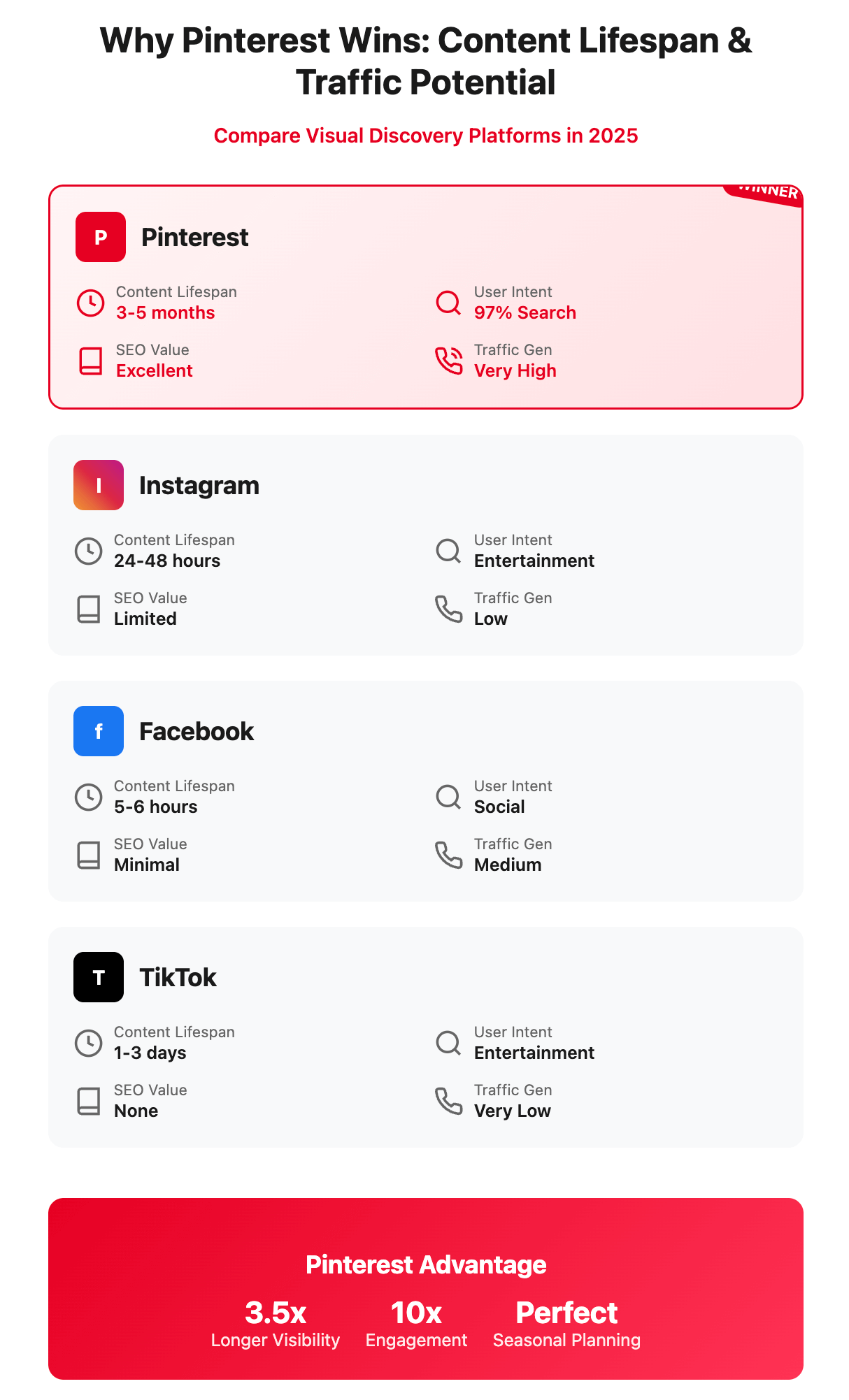
Build Your Pinterest Strategy With Notion Templates & Google Sheets
Free Social Media Content Calendar System With Built-In Planning Tools
Access our strategic free content planning system tailored for visual discovery platforms. This comprehensive, Notion-based tool helps you stay organized and consistently produce seasonal content throughout the year.
Core Features of Our Planning System:
- Monthly planning sections (January through December)
- Pre-researched seasonal keywords for each month
- Content brainstorming frameworks organized by niche
- Performance tracking formulas to measure metric improvements
- Weekly Pinterest Planning System for Consistent Publishing
- Framework for Executing Targeted Media Campaigns with Precision
Content Category Organization:
- Original blog post promotion content
- Product showcase and lifestyle integration
- Seasonal and evergreen content balance
- User-generated content curation
- Educational and authority-building content
Strategic Planning Elements: This structured planning approach enables you to anticipate seasonal demand patterns more effectively. Each section includes keyword ideas, content themes, publishing rhythm tips, and built-in performance tracking tools.
Plan content ideas months using our seasonal insights, then fine-tune your approach based on real performance metrics. This structured method helps you adapt while staying consistent.
Marketing Strategy and Implementation Best Practices
Getting Started with Your Content Calendar:
- Assessment Phase: Analyze your current visual content presence and identify areas for strategic improvement.
- Goal Setting: Define clear objective markers for traffic, engagement, and conversion improvements
- Content Audit: Review existing content performance to understand what resonates with your audience
- Strategic Planning: Create a content calendar that aligns with seasonal trends and audience behavior
Monthly Content Creation Process:
- Week 1: Research popular topics and seasonal keywords for the upcoming months.
- Week 2: Create content in batch sessions to save time and maintain consistency
- Week 3: Edit and optimize content for maximum discoverability
- Week 4: Publish and monitor your visual content performance metrics to ensure ongoing improvement.
This planning framework integrates smoothly with top tools and includes built-in tracking to evaluate the effectiveness of your visual content. You can use Notion or adapt it to your preferred planning system.
↑ Back to Table of ContentsTracking Your Pinterest Growth: Productivity Metrics & Pin Engagement
Real Creator Success Stories
Food Blogger Transformation Case Study:
A dedicated food blogger implemented strategic seasonal planning based on our content organization framework, focusing on early content creation and systematic keyword optimization.
Execution Plan:
- Created a 90-day strategic media plan
- Developed engaging content using multiple visual formats per recipe
- Optimized posting schedule based on seasonal search patterns
- Applied targeted seasonal tactics to boost reach for holiday baking content.
Measurable Results:
- Increase in traffic: 340% growth (15K to 66K monthly visitors)
- Revenue improvement: 280% growth through strategic affiliate partnerships
- Top performing content: “25 Make-Ahead Christmas Cookies” achieved 2.3M impressions
- Email list growth: 450% increase from visual discovery platform traffic
E-commerce Business Success Story: A home decor business learned how to create systematic seasonal campaigns that aligned product launches with search behavior patterns.
Strategic Approach:
- Created content showcasing products in real lifestyle contexts
- Continuously track how your shopping content performs to optimize conversions and drive sales.
- Developed comprehensive seasonal collection launches
- Stayed consistent with brand aesthetic while adapting to seasonal themes
Performance Outcomes:
- Sales growth: 520% increase in platform-driven revenue ($8K to $49K monthly)
- A conversion-minded approach resulted in a 35% higher average order value
- Best campaign performance: Spring porch decor generated $12K in direct sales
- Customer acquisition: 180% follower growth with high engagement rates
Performance Tracking and Analytics
Key Metrics for Strategic Success:
Understanding which metric indicators matter most helps you refine your approach and make data-driven adjustments for better results. For a full walkthrough of platform analytics and metric interpretation, explore our guide to tracking performance and SEO impact.
Primary Performance Indicators:
- Monthly impression growth and reach expansion
- Click-through rates by content type and seasonal timing
- Conversion rates from the visual discovery platform traffic
- Audience growth and engagement quality metrics
Mastering Advanced Analytics:
- Analyze seasonal performance patterns to fine-tune your future content timing.
- Monitor competitor performance to identify high-interest topics in your niche.
- Analyze audience demographic data to refine content targeting
- Measure the increase in traffic attribution to specific campaigns and content types
Strategic Adjustment Framework: Use performance data to help you grow your reach systematically. Get organized with monthly performance reviews that identify successful content patterns and areas for improvement.
↑ Back to Table of ContentsFAQ: Create a Content Calendar That Helps You Grow and Stay Ahead in 2025
How far in advance should I plan my Pinterest content planner strategy?
Plan visual content 60-90 days in advance for optimal performance. Users search seasonally, with Christmas planning beginning in September and spring content gaining traction in January. This forward-thinking approach allows your content to gain momentum before peak search periods, helping you stay ahead of the competition.
What’s the ideal posting frequency for 2025 success?
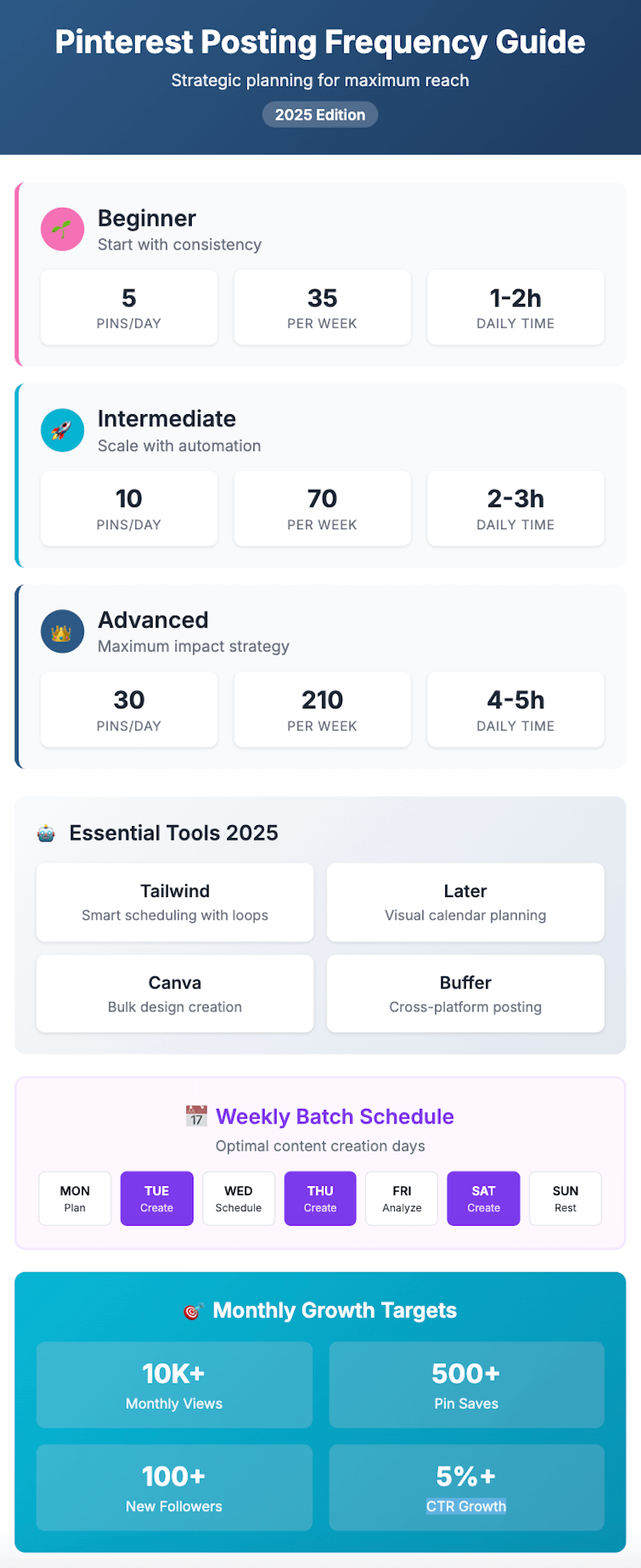
Create and schedule 5-30 posts daily, based on your resources and growth goals. Prioritize quality over quantity—focus on valuable, well-optimized content rather than hitting specific numbers. Maintain a consistent and sustainable posting schedule you can stick to long-term, while keeping your content fresh.
Where can I find effective Pinterest content ideas for each season?
Use the platform’s Trends tool, seasonal keyword research, and competitor analysis for inspiration. Focus on evergreen topics with seasonal angles, like “cozy fall recipes” or “spring cleaning organization.” Get organized with a content idea bank that you can reference throughout the year to save time during busy periods.
Should I create multiple designs for the same content?
Yes, create content in 3-5 different visual formats for each topic or blog post. This approach can boost traffic by 300–500% while helping you test what resonates with your audience. Edit designs to test different styles, colors, and text overlays to optimize performance.
How do I measure if my content calendar is working effectively?
Track your visual platform metrics, such as impressions, profile visits, clicks, and saves, and watch for patterns over time rather than short-term spikes. Use native analytics to identify your top-performing content types and seasonal patterns, then adjust your calendar accordingly to help you systematically grow your reach.
What tools can help me get started with content planning?
Popular marketing tool options include scheduling platforms, design software, and analytics tools. Many creators use Notion for planning and organization, while others prefer specialized visual content management platforms. Choose tools that help you create content efficiently while maintaining quality and consistency.
How can I optimize my existing content for better performance?
Edit underperforming content by updating descriptions with seasonal keywords, refreshing visual elements, and improving text overlays. Refine your use of hashtags and make sure each pin delivers clear value to your audience. Keep your content fresh by periodically updating popular designs with new seasonal elements.
↑ Back to Table of ContentsConclusion: Use Notion and Smart Planning to Create Your Pinterest Future
A strategic Pinterest content planner transforms random posting into a data-driven approach that generates consistent traffic and revenue year-round. By aligning your content with seasonal search behavior and user intent, you can maximize visibility and engagement while fostering sustainable, long-term growth.
Success on visual discovery platforms isn’t about luck—it’s about strategic planning, understanding audience needs, and consistently delivering valuable content. Whether you’re driving blog traffic, increasing affiliate conversions, or boosting e-commerce sales, this systematic approach provides a reliable foundation for achieving marketing success in 2025.
Your Strategic Action Plan
Immediate Implementation Steps:
- Get started by downloading our free content calendar system and begin planning seasonal content 90 days in advance.
- Plan your visual content using the monthly breakdown provided to stay consistent and relevant throughout the year.
- Organize your content creation system to batch-produce materials during periods of low competition.
- Optimize your existing content with seasonal keywords and improved visual elements.
Approach for Sustained Growth:
Create a content calendar that serves your audience’s seasonal needs while building your authority in your chosen niche. Help you create sustainable systems that save time while maintaining high-quality, engaging content standards.
The systematic roadmap provided in this guide helps you stay consistent with your content plan while adapting to platform changes and audience preferences. Regularly track your performance on visual discovery platforms and refine your approach based on data-driven insights.
Final Success Framework
Every pin you publish has the potential to drive discovery, clicks, and traffic for months, not hours. To fully capitalize on the long-tail visibility of visual search platforms, stay consistent, align your posts with seasonal search intent, and execute your strategy with purpose.
Start implementing your visual content plan today using this proven media planner framework. When you combine strategic timing with high-quality visual content, results will compound over time — bringing long-term traffic, audience growth, and revenue opportunities.
Get organized. Plan with intention. Deliver the seasonal content your audience is already searching for.
Your future growth depends on the content decisions you make today.
👉 Want exclusive content ideas, seasonal keyword packs, and behind-the-scenes Pinterest strategies?
Join the Telegram channel: BloggingRevenue

